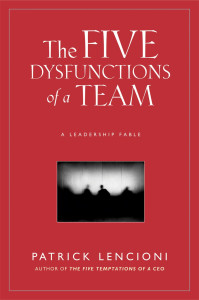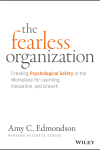The Five Dysfunctions of a Team
A Leadership Fable
"The Five Dysfunctions of a Team" presents a comprehensive model for understanding and overcoming the fundamental causes of team failure. Through a leadership fable followed by detailed analysis, Lencioni introduces a practical framework that helps leaders identify and address common team challenges.
The book demonstrates how five interrelated dysfunctions - absence of trust, fear of conflict, lack of commitment, avoidance of accountability, and inattention to results - prevent teams from achieving their potential. Each dysfunction builds upon the previous ones, creating a model that helps diagnose and address team issues systematically.
Lencioni provides concrete tools and exercises for overcoming these dysfunctions, making the concepts immediately applicable in real workplace situations. The book's approach combines theoretical understanding with practical implementation, helping leaders build and maintain high-performing teams.
By reading "The Five Dysfunctions of a Team," you will:
- Master the pyramid of team effectiveness: Understand how trust, conflict, commitment, accountability, and results interconnect to create high-performing teams.
- Develop practical trust-building techniques: Learn specific exercises and approaches to create psychological safety and encourage vulnerability-based trust.
- Implement systems for productive conflict and accountability: Create frameworks that encourage healthy debate and establish peer-to-peer accountability.
- Transform team focus from individual to collective results: Learn how to align team members around shared goals and measurable outcomes.
Books to Follow:
- "Overcoming the Five Dysfunctions of a Team: A Field Guide" by Patrick Lencioni - Practical exercises and tools for implementing the framework
- "Dare to Lead" by Brené Brown - Deep dive into vulnerability and trust in leadership
- "The Fearless Organization" by Amy Edmondson - Explores psychological safety in teams
- "The Advantage" by Patrick Lencioni - Organizational health framework that builds on team effectiveness
Trust as Foundation
Team effectiveness starts with vulnerability-based trust. Leaders must model vulnerability first, sharing their mistakes and limitations. This creates psychological safety for others to do the same, enabling genuine collaboration and healthy conflict.
Productive Conflict
Without conflict, teams make inferior decisions. Teams need “conflict permission” - explicit understanding that disagreement about ideas is not only acceptable but necessary. Focus should be on issues, not personalities.
Commitment Through Clarity
Clear decisions, even if not unanimous, are better than no decisions. Team members need to voice their opinions (weigh in) to eventually support the decision (buy in). Clarity and closure prevent ambiguity that leads to lack of commitment.
Peer Accountability
Team members must hold each other accountable, not rely solely on the leader. This requires clear standards, public commitments, and regular progress reviews. Accountability fails without trust and commitment foundations.
Results Focus
Teams must prioritize collective outcomes over individual success. Public scorecards, team-based rewards, and regular results reviews help maintain focus on shared goals rather than individual achievements.
Q: What are the five dysfunctions of a team and how do they relate to each other?
A: The five dysfunctions build upon each other in a pyramid model:
- Absence of Trust (foundation): Team members are unwilling to be vulnerable and admit mistakes, weaknesses, or needs for help
- Fear of Conflict: Without trust, teams cannot engage in unfiltered, constructive debate of ideas
- Lack of Commitment: Without honest debate, team members rarely buy in or commit to decisions
- Avoidance of Accountability: Without real commitment, team members hesitate to call out peers on actions that hurt the team
- Inattention to Results: Without accountability, team members put their individual needs above team goals
Each dysfunction builds on the previous one, making it crucial to address them from the foundation up. You cannot have real commitment without healthy conflict, which in turn requires trust.
Q: How do you build trust in teams with a history of conflict or distrust?
A: Start with structured exercises that allow for small, safe instances of vulnerability. The leader must go first, sharing genuine mistakes or weaknesses. Build gradually through regular trust-building activities and consistent behavior that demonstrates psychological safety.
Q: What’s the difference between healthy and unhealthy conflict?
A: Healthy conflict focuses on ideas and issues, not personalities. It’s time-bound, solution-oriented, and happens in an environment of trust. Unhealthy conflict gets personal, avoids real issues, or becomes political rather than productive.
Q: How do you implement accountability without damaging team relationships?
A: Build accountability on a foundation of trust and clear expectations. Create systems for peer-to-peer accountability rather than relying on leader enforcement. Make standards public and review progress regularly as a team.
Q: What if team members resist being vulnerable or sharing weaknesses?
A: Start small and lead by example. Create structured exercises where sharing is expected and safe. Celebrate instances of vulnerability and demonstrate how it benefits the team. Build gradually over time.
Q: How long does it typically take to see improvement in team dynamics?
A: While some improvements can be immediate, meaningful change usually takes 3-6 months of consistent effort. Trust-building particularly requires time and consistency. Focus on small wins while maintaining long-term commitment to the process.
- When forming new teams: Establish healthy team dynamics from the start by understanding and preventing common dysfunctions.
- During team performance issues: Diagnose and address underlying causes of team dysfunction rather than treating symptoms.
- When transitioning to leadership roles: Understand how to build and maintain high-performing teams through systematic approach.
- During organizational change: Help teams navigate uncertainty by strengthening foundational elements of trust and communication.

Your support helps me maintain and improve the book recommendations for everyone.






